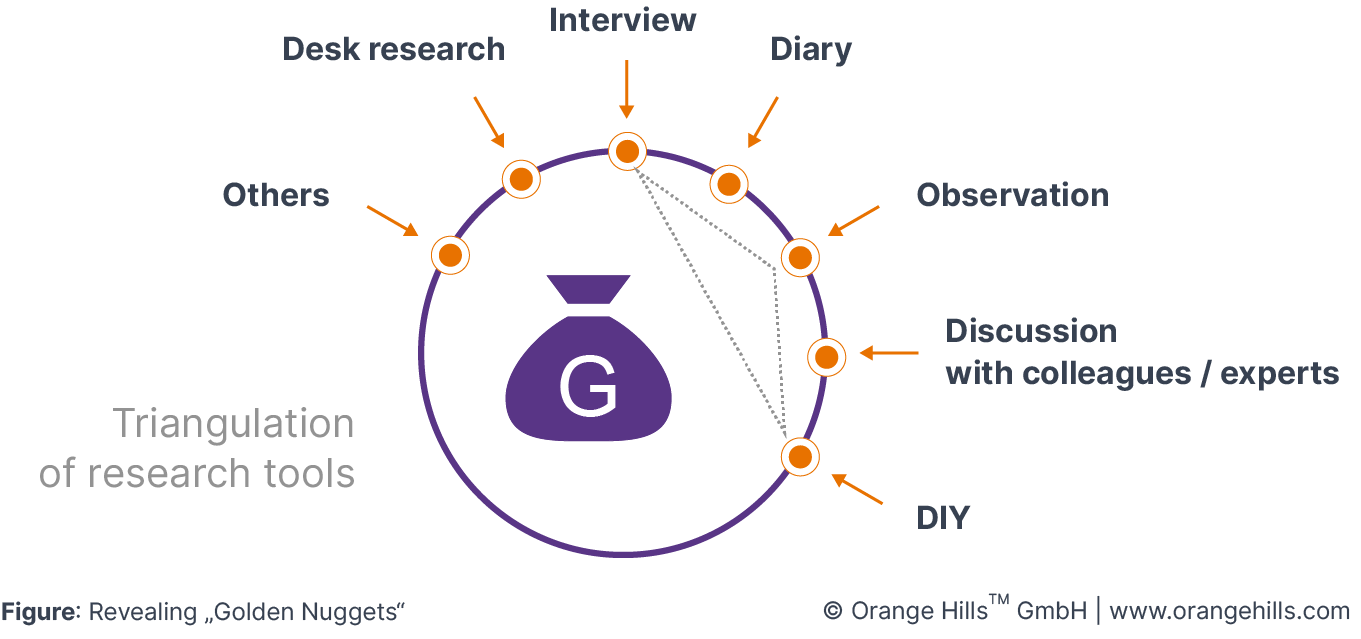Discover Phase

Content
1. Purpose
At the very beginning of a Business Design project, the team members will leave the familiar world of their daily business to enter what is still unknown territory. They need to become expert in this new territory and hunt for both confirming and surprising insights we may use for the upcoming Design Phase. Thus, the "space" of the project focus needs to be discovered. Each team member familiarises himself or herself in virtual teamwork with one or more areas of the innovation space. We propose eight discover areas such as
Today's business model
Practices & processes
Customers & users
Competitive landscape
Market structure & dynamics
Data & resources
Technological capabilities
Rules & regulations
This explorative work is usually prepared in the Kick-off Workshop. This phase usually requires that members of the project team leave their desks and visit experts, customers and other important stakeholders (#GOOTFB). Thus, the magic happens not in the Kick-off Workshop but right after when team members start exploring the outside world. There is a vast variety of options to shed light into the innovation space in the Discover phase. By combining different sources to discover the innovation space from different angles (triangulation) chances for revealing "golden nuggets" are high.

Weekly Status Calls help to keep track of the team's activities. The output of the Discover phase is an accumulation of a vast collection of knowledge and insights and that the team members become experts in the areas they discovered. This knowledge and insights will be leveraged intensively in the subsequent phase to design business ideas that matter. Without a proper Discover phase it is almost impossible to come up with valuable ideas in later phases.
Now it's all about gathering information. Be aware that teams tend to gather information that fits their beliefs (see confirmation bias). We can mitigate this bias by involving the whole team into data collection as well as data analysis and by combining different sources (see triangulation above). The best indicator that we are being influenced is that we only gather confirming information and hardly surprising "golden nuggets". So put on the researcher's goggles and stay open to the results!
2. Duration
2,5 weeks
(in some cases we extend the Discover Phase to 4 weeks if in-depth customer and/or technology research is necessary)
3. Key Activities
The following activities represent the core of the Discover phase and will be started in the Kick-off Workshop:
Define discovery space: To avoid an information overload and too many uncertainties surrounding your project, you need to prioritise which areas to delve into. Use the Discover Cards to define which aspects you want to scrutinize in eight proposed discovery directions and gain a better understanding of your project.
Execute discovery: An essential step in the innovation process is to become familiar with your discovery space. This usually requires some individual effort from every team member to learn as much as possible. Ensure that each team member allocates enough time to engage in research and to leverage his / her network for interviews and observations. Please find examples for discovery execution here: Discovering Customers, Discovering Markets, Discovering Competitors.
Document and visualise insights: Individually, provide an overview about which sources you used to acquire data, information and insights. Summarise your key learning in a visual way that can be presented in the upcoming Design Phase.
Organise a "team event" right at the beginning of the Discover phase where the team works together outside of a traditional workshop setting e.g.
Unboxing products of competitors
Visit of a trade fair
Visit of production line
Visit a customer's location
4. Formats
Virtual teamwork to discover unknown territory (e.g. Discovering Customers, Discovering Markets, Discovering Competitors)
5. Participants
Customers and (team) external experts
6. Tools & Materials
7. Q & A
What if team members have the idea to outsource research tasks to an external market research institute? Usually we advise project teams to do the research themselves. The reason is simple: We want team members to get first-hand impressions from their customers and users and not look at tables and pie charts with pre-analyzed insights from others. We want them to look into their customers' eyes and feel the emotions they have in their today's world. Moreover, we have experienced quite often that many research institutes are not experienced in qualitative research in the context of innovation management.
What if you realize that the progress of the team members in the Discover phase is very little? This can have many reasons: Lack of time, lack of motivation, methodological problems. A "simple" solution is to invite them to a GTD Workshop (= "Getting Things Done") and try to complete as many focused tasks as possible in one day. It's magic what people can achieve in one day with 100% attention on a task. Nevertheless, keep in mind that this phase is essential to set the "right" work culture. If you don't manage to set the rules here, it will not happen anymore in the project.
How can I make sure that team members identify "golden nuggets"? No matter what kind of area you are discovering, you really have to dig deep to generate useful information. We observed a lot of teams scratching the surface and bringing back a tonne of useless high-level bullsh*t (see picture below). Exciting innovation with 100% market fit can only take place when you put the scientists's goggles on, scrutinise your findings and don't be satisfied with the first answer you hear or the first information you find.

